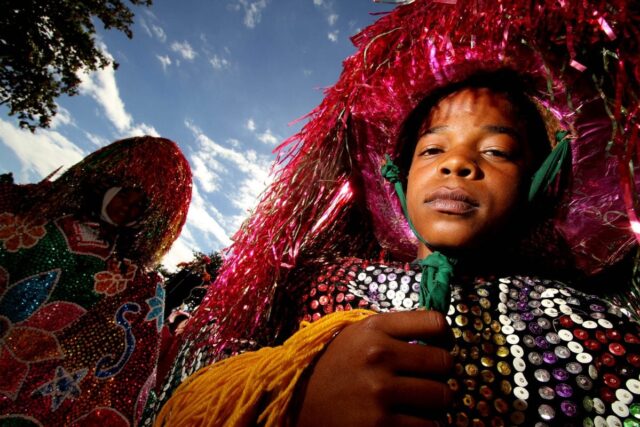Considered in states such as Pernambuco e Ceará a cultural tradition that rescues regional history and culture, the Maracatu It is a festival that enchants not only with the music, but also with the brilliant and detailed costumes. Behind presentations that last a few days, there is an entire year’s work carried out by volunteer seamstresses. They are the ones who keep the tradition alive, “out of love and with love” for Maracatu, because unlike the samba schools in Rio de Janeiro and São Paulo, the groups receive little municipal support.
The first records of Maracatu appear at the beginning of the 18th century and are a symbolic representation of life in Colonial Brazil. When the planters went out for parties, the slaves stayed in the slave quarters, imitating what the big house was like. When the royal family went out, there was always a lady who accompanied them with a large umbrella to protect them from the sun or rain. All these characters exist in Maracatu, which is divided into two types, depending on the baque: Maracatu Nação (Baque Virado) and Maracatu Rural (Baque Solto).
In Maracatu Rural, located in Zona da Mata Pernambucana, the lance caboclos carry out a parade that resembles a battle. Running from one side to the other, they are the ones pulling the cord. The center of the procession is surrounded by Bahian women, bouquet ladies, calunga – a cloth or plastic doll – and feather caboclos.
The state cultural department of Pernambuco highlights that religion is also involved in Maracatu, with an indigenous and Afro-Brazilian mix. There are tributes to Zé Pilintra, an Umbanda entity, and rue branches behind the ears of spear caboclos, along with a carnation or white rose in the mouth to keep the body “closed”. The details are diverse and it would be awkward to discuss them here without images, so you can check out the photo gallery from FUNDARPE (Foundation for the Historical and Artistic Heritage of Pernambuco) at the end of the article.
The sewing
The seamstress character does not appear in the fashion shows, but she is present in each costume. There are days, weeks and even months of sewing, embroidering – many parts by hand – washing and revitalizing the costumes. A Ceroula can weigh up to 30 kilos, the Bahian women wear iron hoops under their clothes and the more embroidery, the more shine, the better. “On the flag, we do the letters, the embroidery, one by one, with 6mm sequins”, says Marinalva de Freitas, a seamstress at the Maracatu Feminino de Baque Solto Coração Nazareno.
To make the dresses have puffy sleeves, the seamstresses buy 10 meters of fabric. There are feathers, straw, shells, beads, sequins, lace, sometimes sewn by hand, sometimes by machine. “When Carnival ends, we start to see what the next year will be like”, he explains.
Therefore, the value of each costume can exceed one thousand reais. But no one pays that amount. “These are issues that if a seamstress were to charge, Maracatu cannot afford it, so we often do it voluntarily, we do it out of love for culture”, reports Rita Costa, a seamstress at the Maracatu Obalomifrom Fortaleza.
Rita estimates that a Bahian costume costs R$1,000 to R$1,200, whereas in the case of a queen, which is more detailed, with stone work, R$3,000. As there are only four seamstresses at Maracatu Obalomi, they started working three months earlier, due to demand and little funding coming into the group’s cash flow via city hall. “Seamstresses stop other activities during Carnival. But the truth is that Maracatu is ongoing all year long and all of this requires our attention. Without a seamstress, it won’t come out”, he adds.
Eliane Rodrigues, Executive Coordinator of AMUNAM (Associação das Mulheres de Nazaré da Mata), who created the Maracatu Feminino Coração Nazareno project, states that Maracatu is still very undervalued, despite its historical-cultural importance and the emphasis given by city halls and states . “The municipality pays a brega singer to perform at Carnival an average of R$100,000. For Maracatu, they want to pay R$400”, he explains, “sometimes, this singer has a production of 10 people. Maracatu has 70, sometimes 200 people. So, there are 200 outfits too.”
Maracatu Feminino Coração Nazareno is located in Nazaré da Mata, a city considered the state capital of Maracatu, with 23 groups. Even though it is recognized as a form of expression and cultural heritage of Brazil by IPHAN (Institute of National Historical and Artistic Heritage) the financial condition means that the majority of people who are in charge of Maracatu, whether on the board or the players, put their hands in money (and in your pocket) to keep this culture alive.
Eliane, Marinalva and Rita not only share their affection for the festivities, but also the recognition of the importance of keeping history alive. Since 2015, Fortaleza recognizes Maracatu as intangible heritage, a sign of resistance and its gigantic cultural dimension. “Many people don’t know, they don’t care about this culture that is so rich because it is a culture that comes from slaves and people are prejudiced”, explains Rita.
Maracatu not only brings the history of Colonial Brazil, but also regional stories, important for the individual’s connection with the space they inhabit. “The youth, the children, don’t know what this story is. They need to know that no one arrived here from nowhere, that many black people were enslaved and we are here today telling this story”, highlights Eliane, “if we don’t recognize our past, how are we going to live in the present and the future? ”.





